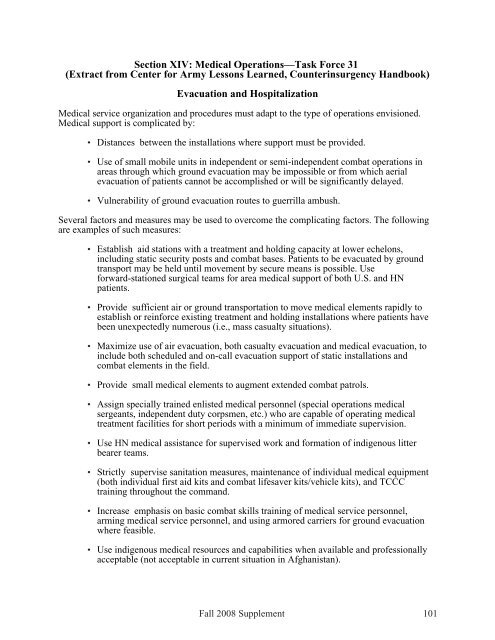Training Supplement - United States Special Operations Command
Training Supplement - United States Special Operations Command
Training Supplement - United States Special Operations Command
You also want an ePaper? Increase the reach of your titles
YUMPU automatically turns print PDFs into web optimized ePapers that Google loves.
Section XIV: Medical <strong>Operations</strong>—Task Force 31<br />
(Extract from Center for Army Lessons Learned, Counterinsurgency Handbook)<br />
Evacuation and Hospitalization<br />
Medical service organization and procedures must adapt to the type of operations envisioned.<br />
Medical support is complicated by:<br />
• Distances between the installations where support must be provided.<br />
• Use of small mobile units in independent or semi-independent combat operations in<br />
areas through which ground evacuation may be impossible or from which aerial<br />
evacuation of patients cannot be accomplished or will be significantly delayed.<br />
• Vulnerability of ground evacuation routes to guerrilla ambush.<br />
Several factors and measures may be used to overcome the complicating factors. The following<br />
are examples of such measures:<br />
• Establish aid stations with a treatment and holding capacity at lower echelons,<br />
including static security posts and combat bases. Patients to be evacuated by ground<br />
transport may be held until movement by secure means is possible. Use<br />
forward-stationed surgical teams for area medical support of both U.S. and HN<br />
patients.<br />
• Provide sufficient air or ground transportation to move medical elements rapidly to<br />
establish or reinforce existing treatment and holding installations where patients have<br />
been unexpectedly numerous (i.e., mass casualty situations).<br />
• Maximize use of air evacuation, both casualty evacuation and medical evacuation, to<br />
include both scheduled and on-call evacuation support of static installations and<br />
combat elements in the field.<br />
• Provide small medical elements to augment extended combat patrols.<br />
• Assign specially trained enlisted medical personnel (special operations medical<br />
sergeants, independent duty corpsmen, etc.) who are capable of operating medical<br />
treatment facilities for short periods with a minimum of immediate supervision.<br />
• Use HN medical assistance for supervised work and formation of indigenous litter<br />
bearer teams.<br />
• Strictly supervise sanitation measures, maintenance of individual medical equipment<br />
(both individual first aid kits and combat lifesaver kits/vehicle kits), and TCCC<br />
training throughout the command.<br />
• Increase emphasis on basic combat skills training of medical service personnel,<br />
arming medical service personnel, and using armored carriers for ground evacuation<br />
where feasible.<br />
• Use indigenous medical resources and capabilities when available and professionally<br />
acceptable (not acceptable in current situation in Afghanistan).<br />
Fall 2008 <strong>Supplement</strong> 101

















